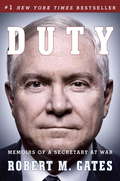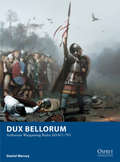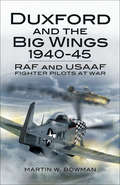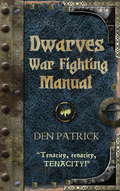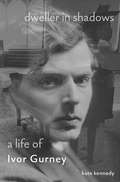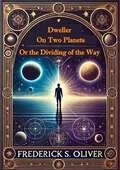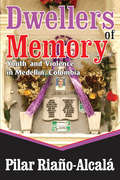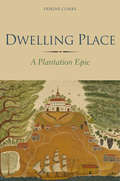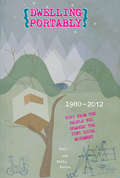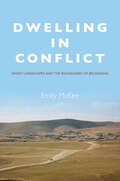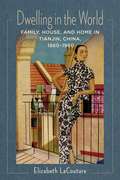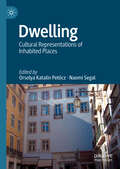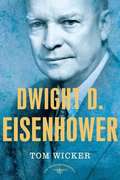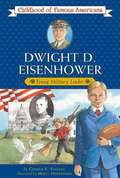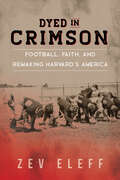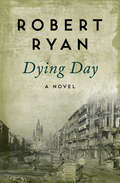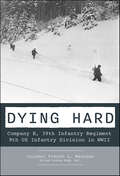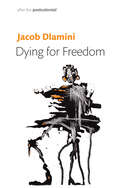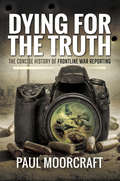- Table View
- List View
Duty: Memoirs of a Secretary at War
by Robert M GatesFrom the former secretary of defense, a strikingly candid, vivid account of serving Presidents George W. Bush and Barack Obama during the wars in Iraq and Afghanistan. When Robert M. Gates received a call from the White House, he thought he'd long left Washington politics behind: After working for six presidents in both the CIA and the National Security Council, he was happily serving as president of Texas A&M University. But when he was asked to help a nation mired in two wars and to aid the troops doing the fighting, he answered what he felt was the call of duty.
Dux Bellorum # Arthurian Wargaming Rules AD367-793
by Daniel Mersey Jose PenaThe Dark Age of Britain, from the middle of the 4th century to the end of the 8th, was a time of violence and warfare, when charismatic warlords such as the fabled King Arthur could gather together armies and carve out their own kingdoms. With this new set of wargames rules, players can take on the role of these warlords and command their own armies on the tabletop. Written by the author of the popular Glutter of Ravens rules set, Dux Bellorum is an element-based system, where each base of figures represents 50 fighting men. Each player has a specific number of points with which to construct his force and can choose a Late Roman, Romano-British, Welsh, Saxon, Pictish, Irish, or Sea Raider army, amongst others. The game is then played out following a set of simple, fast-paced rules. A completely self-contained gaming system, Dux Bellorum is perfect for gamers who are looking for a way into fighting Dark Age battles without investing a lot of time or money in larger rulesets.
Duxford and the Big Wings, 1940–45: RAF and USAAF Fighter Pilots at War
by Martin W. BowmanA pulsating account of the young RAF and American fighter boys who flew Spitfires, Hurricanes, Thunderbolts and Mustangs during 1940-45. It is unique in that the story is told using first person accounts from RAF, German and American Eagles who fought in the skies over England in the Battle of Britain in the summer of 1940 and the great air offensives over occupied-Europe from 1942 onwards. The first five and a half chapters cover the Battle of Britain period when the RAF squadrons fought dog fights with the Luftwaffe and then fought them in gathering strength using the Big Wings to meet the bomber fleets attacking London. The second part of the book covers the Eagle squadron period, which was expanded with Americas entry into the war. The action moves to the USAAF Big Wings of Thunderbolts and Mustang fighters that flew escort missions and dueled with the Luftwaffe over the continent during the massive bomber raids on German targets in France, the Low Countries and the Reich itself. A whole host of incredible first hand accounts by British, Polish, Czech, German and American fighter pilots permeate the action and describe the aerial battles as only they can. This unique book also includes many accounts and photos that have not previously been seen before while the rich mix of combat accounts from all sides are brought together for the first time in one volume.
Dvorak's Prophecy: And The Vexed Fate Of Black Classical Music
by Joseph HorowitzA Kirkus Reviews Best Nonfiction Book of 2021 A provocative interpretation of why classical music in America "stayed white"—how it got to be that way and what can be done about it. In 1893 the composer Antonin Dvorák prophesied a "great and noble" school of American classical music based on the searing "negro melodies" he had excitedly discovered since arriving in the United States a year before. But while Black music would found popular genres known the world over, it never gained a foothold in the concert hall. Joseph Horowitz ranges throughout American cultural history, from Frederick Douglass and Huckleberry Finn to Gershwin’s Porgy and Bess and the work of Ralph Ellison, searching for explanations. Challenging the standard narrative for American classical music fashioned by Leonard Bernstein and Aaron Copland, he looks back to literary figures—Emerson, Melville, and Twain—to ponder how American music can connect with a "usable past." The result is a “new paradigm” that makes room for Black composers including Harry Burleigh, Nathaniel Dett, William Dawson, and Florence Price to redefine the classical canon.
Dwarves War-Fighting Manual
by Den PatrickA manual, complete with illustrations, that looks at the dwarvish race and the way they fight war. With a history of the race, an assessment of the legendary courage and fortitude of the dwarves in war, and accounts of famous engagements, this is the perfect companion for any fantasy wargamer or roleplayer, as well as being a door into a wonderful and original fantasy world.
Dwarves War-Fighting Manual
by Den PatrickA manual, complete with illustrations, that looks at the dwarvish race and the way they fight war. With a history of the race, an assessment of the legendary courage and fortitude of the dwarves in war, and accounts of famous engagements, this is the perfect companion for any fantasy wargamer or roleplayer, as well as being a door into a wonderful and original fantasy world.
Dweller in Shadows: A Life of Ivor Gurney
by Kate KennedyThe first comprehensive biography of an extraordinary English poet and composer whose life was haunted by fighting in the First World War and, later, confinement in a mental asylumIvor Gurney (1890–1937) wrote some of the most anthologized poems of the First World War and composed some of the greatest works in the English song repertoire, such as “Sleep.” Yet his life was shadowed by the trauma of the war and mental illness, and he spent his last fifteen years confined to a mental asylum. In Dweller in Shadows, Kate Kennedy presents the first comprehensive biography of this extraordinary and misunderstood artist.A promising student at the Royal College of Music, Gurney enlisted as a private with the Gloucestershire regiment in 1915 and spent two years in the trenches of the Western Front. Wounded in the arm and subsequently gassed during the Battle of Passchendaele, Gurney was recovering in hospital when his first collection of poems, Severn and Somme, was published. Despite episodes of depression, he resumed his music studies after the war until he was committed to an asylum in 1922. At times believing he was Shakespeare and that the “machines under the floor” were torturing him, he nevertheless continued to write and compose, leaving behind a vast body of unpublished work when he died of tuberculosis. Drawing on extensive archival research and spanning literary criticism, history, psychiatry and musicology, this compelling narrative sets Gurney’s life and work against the backdrop of the war and his institutionalisation, probing the links between madness, suffering and creativity.Facing death in the trenches, Gurney hoped that history might not “forget me quite.” This definitive account of his life and work helps ensure that he will indeed be remembered.
Dweller on Two Planets or the Dividing of the Way: Or, The Dividing Of The Way
by Phylos The Thibetan Frederick S. OliverDweller on Two Planets or the Dividing of the Way by Frederick S. Oliver is a captivating and visionary work that offers a profound glimpse into the mystical and esoteric realms of Atlantis, reincarnation, and spiritual evolution. Written in the late 19th century and first published posthumously in 1905, this book has become a classic in the genre of metaphysical literature, inspiring readers with its rich narrative and deep spiritual insights.The story unfolds through the experiences of Phylos the Thibetan, a soul who recounts his lives in both the ancient civilization of Atlantis and in 19th-century America. Through his memories, Phylos reveals the advanced technologies, spiritual practices, and societal structures of Atlantis, painting a vivid picture of a highly developed culture that ultimately falls due to its moral and spiritual decline.Dweller on Two Planets explores themes of karma, reincarnation, and the soul’s journey toward enlightenment, offering readers a vision of a universe where the physical and spiritual worlds are intricately connected. Oliver, through the voice of Phylos, delves into the mysteries of life, death, and the afterlife, presenting a cosmic perspective on the nature of existence and the purpose of human life.The book also introduces readers to advanced concepts such as telepathy, levitation, and the use of energy crystals, which were supposedly common in Atlantis. These elements have intrigued and influenced many who are interested in the possibilities of human potential and the hidden knowledge of ancient civilizations.Dweller on Two Planets is more than just a tale of lost civilizations; it is a spiritual guide that encourages readers to reflect on their own paths and the choices that shape their destiny. Frederick S. Oliver’s work remains a timeless piece of esoteric literature, offering a blend of adventure, mysticism, and spiritual wisdom that continues to resonate with seekers of truth.This book is essential reading for anyone interested in Atlantis, metaphysics, or the spiritual journey of the soul. Dweller on Two Planets invites readers to explore the boundaries of reality and consciousness, challenging them to consider the greater mysteries of the universe and their place within it.
Dwellers of Memory: Youth and Violence in Medellin, Colombia
by Pilar Riano-AlcalaDwellers of Memory is an ethnographic study of how urban youth in Colombia came to be at the intersection of multiple forms of political, drug-related, and territorial violence in a country undergoing forty years of internal armed conflict. It examines the ways in which youth in the city of Medellin reconfigure their lives and, cultural worlds in the face of widespread violence. This violence has transgressed familiar boundaries and destroyed basic social supports and networks of trust. This volume attempts to map and understand its patterns and flows.The author explores how Medellin's youth locate themselves and make, sense of violence through contradictory and shifting memory practices. The violence has not completely taken over their cultural worlds or their subjectivities. Practices of remembering and forgetting are key methods by which these youth rework their identities and make sense of the impact of violence on their lives. While the experience of violence is rooted in urban space and urban youth, the memory dwellers use a sense of place, oral histories of death, and narratives of fear as survival strategies for inhabiting violent neighborhoods. The book also examines fissures in memory, the contradictory constructions of young people's subjective selves, and practices of gendered violence and terror. All have and continue to pose risks to the historical memory and cultural survival of the residents of Medellin.Dwellers of Memory offers an alternative ethnographic approach to the study of memory and violence, one that calls into question whether the, role of the ethnographer of violence is to be a mere witness of terror, or to oppose it by writing against it. It will be of interest to sociologists, anthropologists, and students of, ethnography.
Dwelling Place: A Plantation Epic
by Erskine ClarkeWinner of the Bancroft Prize. &“[A] beautifully conceived and penetrating book . . . one of the finest studies of American slavery ever written.&”—The New Republic Published some thirty years ago, Robert Manson Myers&’s Children of Pride: The True Story of Georgia and the Civil War won the National Book Award in history and went on to become a classic reference on America&’s slaveholding South. That book presented the letters of the prominent Presbyterian minister and plantation patriarch Charles Colcock Jones (1804–1863), whose family owned more than one hundred slaves. While extensive, these letters can provide only one part of the story of the Jones family plantations in coastal Georgia. In this remarkable new book, the religious historian Erskine Clarke completes the story, offering a narrative history of four generations of the plantations&’ inhabitants, white and black. Encompassing the years 1805 to 1869, Dwelling Place: A Plantation Epic describes the simultaneous but vastly different experiences of slave and slave owner. This &“upstairsdownstairs&” history reveals in detail how the benevolent impulses of Jones and his family became ideological supports for deep oppression, and how the slave Lizzy Jones and members of her family struggled against that oppression. Through letters, plantation and church records, court documents, slave narratives, archaeological findings, and the memory of the African American community, Clarke brings to light the long-suppressed history of the slaves of the Jones plantations—a history inseparably bound to that of their white owners. &“Clarke&’s magisterial, multiperspective study of the antebellum South describes two family groups . . . a &‘total&’ history of interconnected people divided by race, legal status, and gender.&”—Choice
Dwelling Portably: Tips from the People Who Sparked the Tiny House Movement, 1980-2012
by Bert Davis Holly DavisFull of information about living without a permanent residence, this complete collection contains helpful and informative tips for living far outside of cities and bereft of technology. All of the tips and advice have been edited down to what remains relevant in a technologically changing world, and it is crammed full of informative tips for biking, tents, showering, cooking, and living. Whether camping on the edges, living simply, or getting by on the road and loving it, this book is for modern nomads choosing alternative lifestyles to working 9-5 in the same place.
Dwelling in Conflict
by Emily MckeeLand disputes in Israel are most commonly described as stand-offs between distinct groups of Arabs and Jews. In Israel's southern region, the Negev, Jewish and Bedouin Arab citizens and governmental bodies contest access to land for farming, homes, and industry and struggle over the status of unrecognized Bedouin villages. "Natural," immutable divisions, both in space and between people, are too frequently assumed within these struggles. Dwelling in Conflict offers the first study of land conflict and environment based on extensive fieldwork within both Arab and Jewish settings. It explores planned towns for Jews and for Bedouin Arabs, unrecognized villages, and single-family farmsteads, as well as Knesset hearings, media coverage, and activist projects. Emily McKee sensitively portrays the impact that dividing lines--both physical and social--have on residents. She investigates the political charge of people's everyday interactions with their environments and the ways in which basic understandings of people and "their" landscapes drive political developments. While recognizing deep divisions, McKee also takes seriously the social projects that residents engage in to soften and challenge socio-environmental boundaries. Ultimately, Dwelling in Conflict highlights opportunities for boundary crossings, revealing both contemporary segregation and the possible mutability of these dividing lines in the future.
Dwelling in the World: Family, House, and Home in Tianjin, China, 1860–1960 (Studies of the Weatherhead East Asian Institute, Columbia University)
by Elizabeth LaCoutureBy the early twentieth century, Chinese residents of the northern treaty-port city of Tianjin were dwelling in the world. Divided by nine foreign concessions, Tianjin was one of the world’s most colonized and cosmopolitan cities. Residents could circle the globe in an afternoon, strolling from a Chinese courtyard house through a Japanese garden past a French Beaux-Arts bank to dine at a German café and fall asleep in a British garden city-style semi-attached brick house.Dwelling in the World considers family, house, and home in Tianjin to explore how tempos and structures of everyday life changed with the fall of the Qing Empire and the rise of a colonized city. Elizabeth LaCouture argues that the intimate ideas and practices of the modern home were more important in shaping the gender and status identities of Tianjin’s urban elites than the new public ideology of the nation. Placing the Chinese home in a global context, she challenges Euro-American historical notions that the private sphere emerged from industrialization. She argues that concepts of individual property rights that emerged during the Republican era became foundational to state-society relations in early Communist housing reforms and in today’s middle-class real estate boom.Drawing on diverse sources from municipal archives, women’s magazines, and architectural field work to social surveys and colonial records, Dwelling in the World recasts Chinese social and cultural history, offering new perspectives on gender and class, colonialism and empire, visual and material culture, and technology and everyday life.
Dwelling: Cultural Representations of Inhabited Places
by Naomi Segal Orsolya Katalin PetőczDwelling is both an action and a location; it combines the spatial idea of habitation (dwelling in) with the temporal idea of lingering (dwelling on). We live not only in bricks and mortar, a tent, a hut or a spaceship, but also in that most changeful of forms, our body, or in a remembered or virtual home. Especially since COVID-19 we have seen changes in the topography of everyday life. In this multi-disciplinary collection, a complex of meanings is approached from a variety of specific, often personal angles.Framed by two longer essays which theorise how the psychology of home may change under sudden pressure and how social relations are embodied in windows, doors, walls and stairs, the book includes 18 further essays. Part I, ‘Informal settlements’, shows how a slum, urban development or nomadic life may create a self-sustaining identity; in Part II, ‘Huts and bridges’, impermanence shapes the state of dwelling, while Part III, ‘Liminal bodies’, presents bodies suspended at thresholds of change. Movement in time and space characterises the last three sections: Part IV, ‘Moving home’, depicts transitions and arrivals, Part V, ‘Dwelling in Memory’, focuses on recollections of past places and Part VI, ‘Are we there yet?’, points the way to a future in which the consulting-room changes to 2D, a family is exiled onto the small screen or we imagine breaking away altogether into outer space.
Dwight D. Eisenhower
by Tom WickerAn American icon and hero faces a nation--and a world--in transition. A bona-fide American hero at the close of World War II, General Dwight Eisenhower rode an enormous wave of popularity into the Oval Office seven years later. Though we may view the Eisenhower years through a hazy lens of 1950s nostalgia, historians consider his presidency one of the least successful. At home there was civil rights unrest, McCarthyism, and a deteriorating economy; internationally, the Cold War was deepening. But despite his tendency toward "brinksmanship," Ike would later be revered for "keeping the peace. " Still, his actions and policies at the onset of his career, covered by Tom Wicker, would haunt Americans of future generations.
Dwight D. Eisenhower: Young Military Leader
by George E. StanleyProfiles the famous general of World War II who later became president of the U.S.A. from 1953-1961.
Dyed in Crimson: Football, Faith, and Remaking Harvard's America (Sport and Society)
by Zev EleffIn 1926, Harvard athletic director Bill Bingham chose former Crimson All-American Arnold Horween as coach of the university’s moribund football team. The pair instilled a fresh culture, one based on merit rather than social status, and in the virtues of honor and courage over mere winning. Yet their success challenged entrenched ideas about who belonged at Harvard and, by extension, who deserved to lay claim to the American dream. Zev Eleff tells the story of two immigrants’ sons shaped by a vision of an America that rewarded any person of virtue. As a player, the Chicago-born Horween had led Harvard to its 1920 Rose Bowl victory. As a coach, he faced intractable opposition from powerful East Coast alumni because of his values and Midwestern, Jewish background. Eleff traces Bingham and Horween’s careers as student-athletes and their campaign to wrest control of the football program from alumni. He also looks at how Horween undermined stereotypes of Jewish masculinity and dealt with the resurgent antisemitism of the 1920s.
Dyer (Images of America)
by Paul Anthony Benninghoff Dyer Historical SocietyWhat had once been an ancient shoreline of Lake Michigan, mired with swamp and sand dunes, is today the town of Dyer. Its history consists of the old Sauk Trail-turned-highway, strong-willed and hardworking visionaries such as Aaron Hart who drained the swamps and created farmlands, entrepreneurs who developed the early businesses and established Dyer as a town in 1910, and events such as the arrival of the locomotive and automobile that altered the lives of its citizens and shaped Dyer into the populated and bustling town it is today. From a sleepy farming community to a distant suburb of Chicago, the town of Dyer has a history both rich in its own right and very much tied to American history. One will see how a small American town unique to its geological location is impressed onto the land and how influences by events unfolding beyond its borders can help create, and sometimes jeopardize, its identity.
Dying Day: A Novel (The Post-War Trilogy #3)
by Robert RyanIn this Cold War spy thriller based on actual case files, a beautiful young woman is willing to do whatever it takes to bring her sister home In the darkest days of World War II, Laura McGill and her sister, Diana, were willing to go behind enemy lines on behalf of Britain&’s Special Operations Executive. They knew the risks and were willing to take them for king and country. What they did not expect was that their government would forget all about them once the war was over. It is the spring of 1948, four years since Diana disappeared inside occupied France, and Laura is sick of being ignored—so sick that she is willing to kidnap the head clerk of the SOE at gunpoint in order to learn the name of the spy who ran her sister&’s last mission. The name she gets, James Hadley Webb, will take Laura to Berlin, a divided city on the verge of being cut off from the Western world. Webb is on the front lines of a new kind of war, a shadow war of influence and intrigue—and losing. Laura&’s arrival, unwelcome as it is, may be just what Webb needs to turn things around—and stop his agents from dying. Dying Day is the 3rd book in the Post-War Trilogy, which also includes After Midnight and Last Sunrise.
Dying Every Day: Seneca at the Court of Nero
by James RommFrom acclaimed classical historian, author of Ghost on the Throne (“Gripping . . . the narrative verve of a born writer and the erudition of a scholar” —Daniel Mendelsohn) and editor of The Landmark Arrian: The Campaign of Alexander (“Thrilling” —The New York Times Book Review), a high-stakes drama full of murder, madness, tyranny, perversion, with the sweep of history on the grand scale.<P> At the center, the tumultuous life of Seneca, ancient Rome’s preeminent writer and philosopher, beginning with banishment in his fifties and subsequent appointment as tutor to twelve-year-old Nero, future emperor of Rome. Controlling them both, Nero’s mother, Julia Agrippina the Younger, Roman empress, great-granddaughter of the Emperor Augustus, sister of the Emperor Caligula, niece and fourth wife of Emperor Claudius.<P> James Romm seamlessly weaves together the life and written words, the moral struggles, political intrigue, and bloody vengeance that enmeshed Seneca the Younger in the twisted imperial family and the perverse, paranoid regime of Emperor Nero, despot and madman.<P> Romm writes that Seneca watched over Nero as teacher, moral guide, and surrogate father, and, at seventeen, when Nero abruptly ascended to become emperor of Rome, Seneca, a man never avid for political power became, with Nero, the ruler of the Roman Empire. We see how Seneca was able to control his young student, how, under Seneca’s influence, Nero ruled with intelligence and moderation, banned capital punishment, reduced taxes, gave slaves the right to file complaints against their owners, pardoned prisoners arrested for sedition. But with time, as Nero grew vain and disillusioned, Seneca was unable to hold sway over the emperor, and between Nero’s mother, Agrippina—thought to have poisoned her second husband, and her third, who was her uncle (Claudius), and rumored to have entered into an incestuous relationship with her son—and Nero’s father, described by Suetonius as a murderer and cheat charged with treason, adultery, and incest, how long could the young Nero have been contained?<P> Dying Every Day is a portrait of Seneca’s moral struggle in the midst of madness and excess. In his treatises, Seneca preached a rigorous ethical creed, exalting heroes who defied danger to do what was right or embrace a noble death. As Nero’s adviser, Seneca was presented with a more complex set of choices, as the only man capable of summoning the better aspect of Nero’s nature, yet, remaining at Nero’s side and colluding in the evil regime he created.<P> Dying Every Day is the first book to tell the compelling and nightmarish story of the philosopher-poet who was almost a king, tied to a tyrant—as Seneca, the paragon of reason, watched his student spiral into madness and whose descent saw five family murders, the Fire of Rome, and a savage purge that destroyed the supreme minds of the Senate’s golden age.<P>
Dying Hard: Company B, 39th Infantry Regiment, 9th US Infantry Division in WWII
by French L. MacLeanOf the 177 enlisted men who formed Company B in 1941, less than 7% percent were still with the unit in May 1945. Many of the absent 93% had died hard, brutal deaths in combat. In the mold of the classic Band of Brothers, Colonel French MacLean presents a dramatic, personalized history of a single company of the US Army through brutal combat in battles at locations such as Normandy, the Ardennes and Hürtgen Forests, Merode Castle, and Remagen Bridge. This is the story of the 9th Division's 39th Infantry Regiment, Company B, a true American melting pot of soldiers from diverse ethnic, religious, racial, and national backgrounds, including Black, Hispanic, White, Mexican, Lakota, Quechan, Canadian, Cuban, Hungarian, Austrian, Norwegian, Scottish, Korean, Filipino, Chinese, Italian, Irish, Greek, Polish, Jewish, Catholic, and Protestant. Of the 177 enlisted men who formed Company B in 1941, less than 7% percent were still with the unit in May 1945. Many of the 93% whose lives were lost died hard, brutal deaths in combat. Readers will learn about the heritage, upbringing, and experiences of individual soldiers along with the history of the unit. This is a personal, dramatic history. Numerous "vignettes" appear throughout the text, which provide contextual information about equipment, terminology, locations, and more. They function like a glossary, but with greater detail and narrative effect. In total, 40 photos and 10 maps are included, most of which are previously unpublished. French MacLean is a retired colonel in the US Army and author of more than a dozen books on the Second World War; he is a recognized expert and experienced researcher. His father, Myron, served as a private in Company B.
Dying Times
by Lisa BenjaminThis book accounts the different epidemics and famines that killed millions of people in the past in different parts of the world.
Dying for Freedom: Political Martyrdom in South Africa (After the Postcolonial)
by Jacob DlaminiWhat happens when death becomes the ultimate marker of one’s commitment to one’s freedom? What happens when the opposite of freedom is not unfreedom but death, not slavery but mortality? How are we to think of the right to life when a political demand for dignity and honor might be more important than life itself?Dying for Freedom explores these questions by drawing on archival evidence from South Africa to show how death and conflicting notions of sacrifice dominated the struggle for political equality in that country. This political investment in death as a marker of commitment to the anti-apartheid struggle encouraged a masculinist style of politics in which the fight for freedom was seen and understood by many activists as a struggle literally for manhood. This investment generated a notion of political sacrifice so absolute that anything less than death was rendered suspect. More importantly, it resulted in a hierarchy of death whereby some deaths were more important than others, and where some deaths could be mourned and others not.This highly original account of the necropolitics of the liberation struggle will be of interest to students and scholars throughout the humanities and social sciences and to anyone interested in South Africa.
Dying for the Truth: The Concise History of Frontline War Reporting
by Paul MoorcraftThe role of war correspondents is crucial to democracy and the publics discovery of the truth. Without them, the temptation to manipulate events with propaganda would be irresistible to politicians of all hues.It starts by examining how journalists have plied their trade over the years most particularly from the Crimean War onwards. Their impact on the conduct of war has been profound and the author, an experienced journalist, explains in his frank and readable manner how this influence has shaped the actions of politicians and military commanders. By the same token the media is a potentially valuable tool to those in authority and this two-way relationship is examined.Technical developments and 24 hour news have inevitably changed the nature of war reporting and their political masters ignore this at their peril and the author examines the key milestones on this road.Using his own and others experiences in recent conflicts, be they Korea, Falklands, Balkans, Iraq or Afghanistan, the author opens the readers eyes to an aspect of warfare that is all too often overlooked but can be crucial to the outcome. The publics attitude to the day-to-day conduct of war is becoming ever more significant and this fascinating book examines why.
Dying in Full Detail: Mortality and Digital Documentary
by Jennifer MalkowskiIn Dying in Full Detail Jennifer Malkowski explores digital media's impact on one of documentary film's greatest taboos: the recording of death. Despite technological advances that allow for the easy creation and distribution of death footage, digital media often fail to live up to their promise to reveal the world in greater fidelity. Malkowski analyzes a wide range of death footage, from feature films about the terminally ill (Dying, Silverlake Life, Sick), to surreptitiously recorded suicides (The Bridge), to #BlackLivesMatter YouTube videos and their precursors. Contextualizing these recordings in the long history of attempts to capture the moment of death in American culture, Malkowski shows how digital media are unable to deliver death "in full detail," as its metaphysical truth remains beyond representation. Digital technology's capacity to record death does, however, provide the opportunity to politicize individual deaths through their representation. Exploring the relationships among technology, temporality, and the ethical and aesthetic debates about capturing death on video, Malkowski illuminates the key roles documentary death has played in twenty-first-century visual culture.
